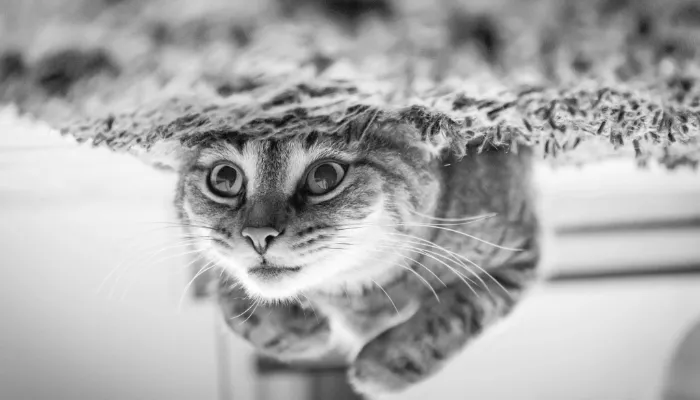English to cat translator is a captivating idea that illustrates how technology could improve interactions with animals. It is self-explanatory that a life where you could interpret the meows, purrs, and tail movements of your beloved cat would be fantastic. The notion of a device or software that translates English into “cat language” has attained immense popularity among cat owners.
These translators promise a new way of interacting with cats by offering a light-hearted way to communicate with pets’ but can we truly rely on this technology? Let’s bring our focus on the superlative technology used by the cat translator and whether it is capable of bridging the gap between cats and humans. For the interested parties, multiple english to cat language translator online tools are accessible for you to try.

English to Cat Translator: Brief Understanding
The concept of an English to Cat Translator is that of a gadget or software created to convert the sounds and actions of your cat into language that a human would understand. This is supposed to work by “translating” your cat’s meows, purrs, and body movements into some form of understandable speech. While this sounds fantastic and extraordinary like science fiction, advancement in technology has made it seem less unreasonable.
However, one core question still exists – does this device actually work? Is it possible to engage in conversations with your cat just as you would with another person? Delving into the scientific, technological, and emotional implications of this astounding stride sheds more light on it.
The English to Cat Translator may appear to be out of a young child’s imagination but the device holds immense potential. Regardless of whether it works or not, such a device will surely alter the way humans interact with their pets.
Why Are People Interested in an English to Cat Translator?
Before we go into detail about how these translators allegedly work, let us step back and analyze why so many people show a keen interest in the concept of having cat sounds converted into human language.
Emotional Connection
- Animals, and in particular cats, are very important in people’s lives. Because cats are somewhat enigmatic, many people wonder what their cats try to convey. An English to Cat Translator could offer a very exciting way to foster deeper emotional bonds between yourself and your pet.
Curiosity
- Cats are intricate creatures, and even after years with humans, they continue to engage in inexplicable actions and sounds. The allure of what is my cat trying to say? often prompts several pet owners to venture out in search of some translation tool that could solve their problems.
Convenience
- For people who may not have a lot of time and are constantly busy, a gadget that interprets what a cat is trying to say or convey would be extremely useful. No guessing means no hassle when trying to determine if your cat is hungry, upset, or just bored and in need of some human attention. Instead, you would get accurate interpretations of your feline friends’ needs and feelings.
There is a strong drive, therefore, to modify these tools as deeply as possible to help connect with pets better and comprehend them more. How well those tools actually deliver on this promise, however, is another question.

How Does an English to Cat Language Translator Online Work?
An English to cat language translator online typically works by capturing the sounds a cat makes alongside the owner’s behavior to correlate those sounds with a response based on pre-programmed research and observation. These systems make use of artificial intelligence (AI) technology to analyze the diversity of sounds that cats create and assign them to meanings.
Cat Translator Apps’ Primary Functions
- Sound Recognition: Some translators, often specializing in difficult languages, start with meows, purrs, growls, and hisses.
- Behavior Analysis: Others use tail and ear placement, facial movements, and other body language aspects to determine the cat’s feelings.
- Artificial Intelligence: A lot of English to Cat language translator online tools apply AI algorithms to track a cat’s communication profile and enhance the accuracy of cat talking features.
Even if these systems are supported by advanced AI, they still have a long way to go before achieving the level of accuracy we’d expect from a human being speaking other languages.
Types of English to Cat Translators
There’s no shortage of english to cat translators in the market these days; cat translator apps and handheld electronics seek to provide a window into your cat’s world.
1. Mobile Apps
- MeowTalk: One of the more popular apps, MeowTalk offers insight into your cat’s meows by trying to interpret them using advanced AI. While it’s not exactly real science, it’s a good way to procure some feedback on your furry friend’s moods.
- Pet Translator: This app claims to help cat owners decode sounds made by their pets using voice recognition. It also allows users to keep a log of their cat’s behavioral patterns to get more detailed information.
2. Wearable Devices
- No More Wuff Pet Translator: This gadget slips around the cat’s collar and tries to attune to its sounds to give responses. For those who love their cats but can’t quite deal with their vocalizations, this is the perfect solution.
3. Online Translators
- ‘english to cat language translator online’ allows cat owners to upload videos or recordings of their cat’s meowing for analysis. These machine-based translators are more focused on engaging one’s self rather than being constructive.
Different options are available for those who wish to seek out said tools. One is different forms of functionality that can be useful in achieving the desired outcome.

Do Cats Really Have a Language?
We need clarification on whether cats can be understood the same way humans can to properly talk about the functionality of an english to cat translator.
Vocalizations
Cats do have several ways to communicate with one another or with humans; however, their system of vocalizations is nowhere near the level of standardization that human languages operate in. Unlike humans, cats don’t have an advanced system of grammar, syntax, and vocabulary, so it is instead reserved for emotions or particular actions.
- Meowing: Cats meow for food, for attention, or in discomfort. The meow, however, comes in several different tones, frequencies, and durations making it particularly difficult to interpret for those who are unfamiliar with cats.
- Purring: Domestic cats make a purring sound to indicate they are relaxed or happy. They may also purr when they experience pain or are under stress, which makes it hard to decipher the meaning.
- Hissing/Growling: Fear or aggression is mainly represented by making these sounds.
Body Language
A cat’s body language is equally important as its sounds. The position of ears, tail, and bodily posture also contain essential information about the cat’s state. For example:
- Tail high: Kittens often express their happiness by raising their tails high.
- Dilated pupils: Can indicate fear, excitement, or stimuli.
- Ears back: Anxiety or irritation is commonly represented by lowered ears.
The need for an English to Cat Translator to incorporate physical appearance alongside sound is evident due to this issue.
A picture of translation attempts and the difficulties that come with it becomes clearer once we delve deeper into how cats communicate through body language and sounds.
Limitations of English to Cat Translator Technology
Even if the concept of having a conversation with your felines sounds fascinating, there are several constraints to the current cat language translator technologies.
1. Absence of Accuracy
- The vocalization of cats is not always consistent. For example, two meows that come out as the same might actually imply something totally different depending on the context. Translators tend to have problems differentiating between these nuances and that leads to inaccurate translations.
2. Dependence on Interpretation
- Even with advanced technology, AI, the correct translation of speech will be largely reliant on a person. For example, a specific meow that sounds like “hungry” might be interpreted as “want attention” meow highly depending on the specific cat.
3. Restrained Range
- Most cat translators come with the downside of limited scope in that most of them have a limited recognition vocabulary but do not capture the full emotional range of the cat outbursts.
4. Dependence on Tools
- Pet owners must be attentive to these devices as being overly dependent on them can lead to more trouble than ease. Understanding a pet’s needs is not so black and white and requires some level of observation, interaction, and emotional connections.
While these tools can offer helpful information from data collection, they also highlight that nothing can take the place of the emotional connection humans feel towards their pets.
How Accurate Are English to Cat Translators?
Translators put forth a good effort, but they’re ultimately half-baked at best: serving a cat’s need requires a lot more than just listening to their vocals. But even in these restricted settings, value is still maintained for several reasons.
- Fun: Almost all devices in this category are entertaining to use and allow pet owners to spend quality time with their cats.
- Knowing One’s Cat: These tools do have utilities at predicting certain aspects of cats’ vocalizations – which is much more complex than just a mere meow.
- Time Efficient: Such devices can be used to ascertain the basic emotions of a cat’s persona quite rapidly.
| Translator Type | Accuracy | Main Use | Pros | Cons |
|---|---|---|---|---|
| Mobile Apps (e.g., MeowTalk) | Moderate | Translating meows | Easy to use, entertaining | Limited accuracy |
| Wearable Devices | Moderate | Continuous translation | Convenient for daily use | Expensive, limited features |
| Online Translators | Low | Fun, occasional translations | Fun for entertainment | Very limited |
Elucidating summarises the market of different cat translator devices citing advantages and disadvantages according to the use and the precision of the devices.
The Future of Cat Translators
The english to cat translator’s technology is not astonishing at the moment, but the prospects are appealing. The evolution of AI, Machine Learning, and pet behavior studies suggests the introduction of tools that can help in improving the understanding of our pets’ worlds.
These instruments promise to become more advanced as we expand our understanding of cat behavior, resulting in positive influences on cat-owner interactions. At this point in time we are still forced to depend on our observations concerning our cats.
With the available features, future advancements of the english to cat translator will be able to assist pet owners in communicating with their pets in more sophisticated ways.
Conclusion
In conclusion, an english to cat translator is definitely effective in trying to cater to the needs of cat owners and explicating a cat’s behavioral patterns as well as its emotions. While it can never talk back to you in the human sense of the word, such translators are useful tools for conveying some message along with your own scrutiny of the situation.
The english to cat language translator online that exists today is primarily designed for fun and offers some semblance of interpretation but it should never attempt to replace the genuine connection you have with your pet cat. So, next time your feline friend decides to meow or purr literally or figuratively, try giving the translators a go, but as always, remember to listen to your friend too!
